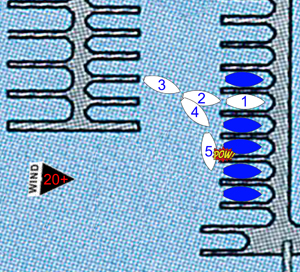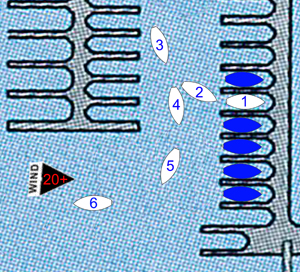Got the blues leaving the downwind slips?
With the onset of summer and the steady winds, we’ve seen a few close calls in the fairway. This looks like a great time to publish a docking skipper’s tip!
When backing out of a downwind slip (wind is blowing into the slip), our Tradewinds acronym L.O.T. is absolutely critical.
Location – should be the far side of the fairway from your slip – as far upwind from the slip as you can safely be.
Orientation – the boat should be as close to perpendicular to the slip (bow is pointed down the fairway) as possible before we make our…
Transition – transition to forward motion (motion, not gear – the gear change happens while we are still moving backward, and we need to remember to steer based on the direction of motion, not the gear we are in!) should be accomplished with enough forward throttle and rudder adjustment to keep the boat pointed in the right direction. Stronger wind will require more throttle and/or rudder to accomplish this, while in light winds we can use very little of either and do fine.
Here are some diagrams to help with the explanation (click them for a larger view):
 |
 |
 |
| In this image, our Location is great – the safer, upwind side of the fairway. Unfortunately, our Orientation is not good (our bow is pointed at the docks). Since our boat steers from the stern, we can’t get our bow around before the wind takes us back to the other side of the fairway and into the docks. If we find ourself in position 3 above, we should consider driving back into the slip and starting over rather than trying to make the difficult Transition and turn against the wind forcing our bow down. |
In this image, our Orientation is good (bow pointed in the right direction), but we’ve already made a large mistake in our Location (the downwind side of the fairway). Making the Transition from postion 3 is a bad idea and will result in being blown back into the docks. If we are in this position, the safest way to attempt recovery is to continue to back with enough speed to steer to the upwind side of the fairway in reverse before making our Transition to forward motion. |
In this example, we are Located on the safe, upwind side of the fairway, our Orientation is in the correct direction, perpendicular to the docks (bow pointed down the fairway), and we have plenty of room and time to make a smooth Transition to forward motion and exit the docks. Well done! |
Like this:
Like Loading...




Great little article and visual. Thanks!
Thanks!
I find it doesn’t hurt to have a crew member ready with a fender on the starboard side at the stern to avoid any dock or boat contact.
My two cents, or perhaps, because of inflation combined with my age, it is down to one:
L: As a reminder I associate L with Location and also with L for Lee shore. Your location should be AWAY from the lee side of the fairway.
O: I got nothin’ here.
T: This is for transition but I associate it also with T for Turn: Between reverse and forward, during your transition, the boat will come to a momentary stop. Since you are not moving, the rudder has no effect. Ask yourself whether at that point the wind direction is going to finish the Turn for you, or whether it will Turn you back in the wrong direction. If the wind will complete your turn, you can shift early; if it will Turn you back in the wrong direction, wait to shift until your orientation is correct.